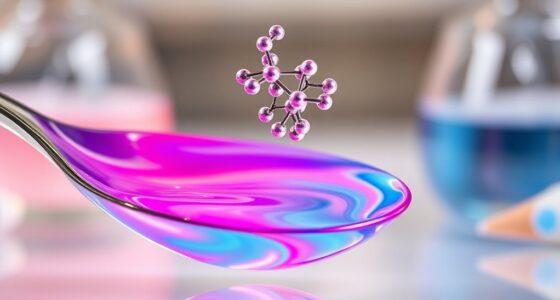Understanding the pH scale is key because it measures how acidic or alkaline a substance is, impacting your health, the environment, and industry processes. It runs from 0 to 14, with 7 being neutral—below is acidic, and above is basic. Accurate pH levels influence everything from water quality and soil health to digestion and manufacturing. Learning more about how pH works can help you grasp why it plays a vital role in daily life and beyond.
Key Takeaways
- The pH scale measures hydrogen ion concentration, indicating acidity (below 7), neutrality (7), or alkalinity (above 7).
- Understanding pH helps manage health, as blood, stomach, and saliva pH impact overall well-being.
- In ecosystems, pH affects aquatic life, water quality, and nutrient availability, maintaining ecological balance.
- Soil pH influences plant growth, nutrient uptake, and microbial activity, essential for successful agriculture.
- Industry relies on precise pH measurement for manufacturing, water treatment, and food safety to ensure product quality.
What Is the Ph Scale and How Is It Measured?
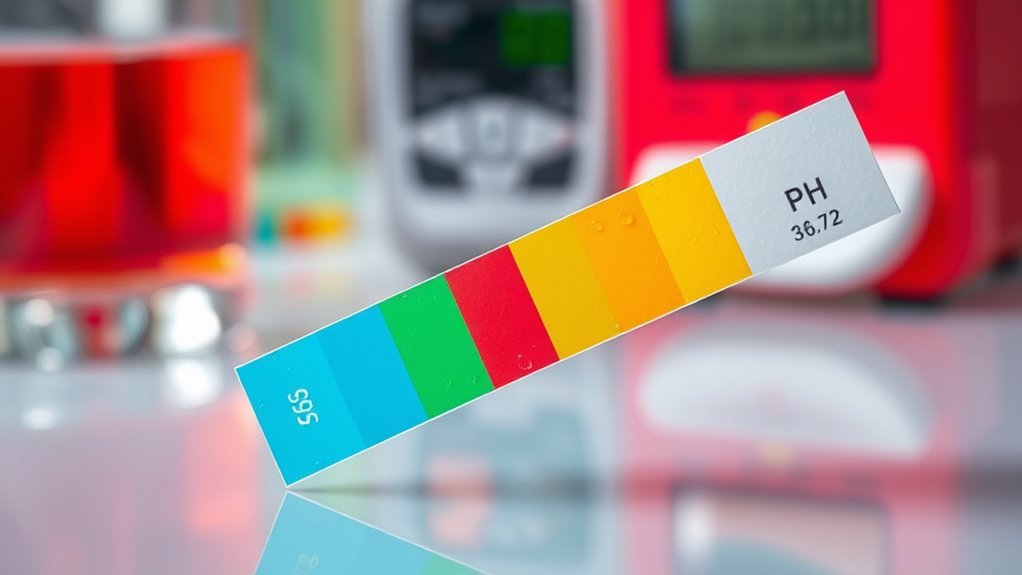
Have you ever wondered how scientists determine whether a liquid is acidic, neutral, or alkaline? The answer lies in the pH scale, which measures the acidity or alkalinity of liquids. The scale runs from 0 to 14, with 7 being neutral, below 7 acidic, and above 7 alkaline. Vetted – 1st Home Theatre Projector Pure water has a pH of about 7 under standard conditions. To measure pH, scientists use glass electrodes connected to pH meters that detect the potential difference caused by hydrogen ion activity. These readings are often calibrated with standard solutions for accuracy. Since pH is logarithmic, each unit change indicates a tenfold difference in acidity or alkalinity. Temperature affects pH measurements, so temperature control or compensation is essential for reliable results.
The Significance of Ph in Daily Life and the Environment
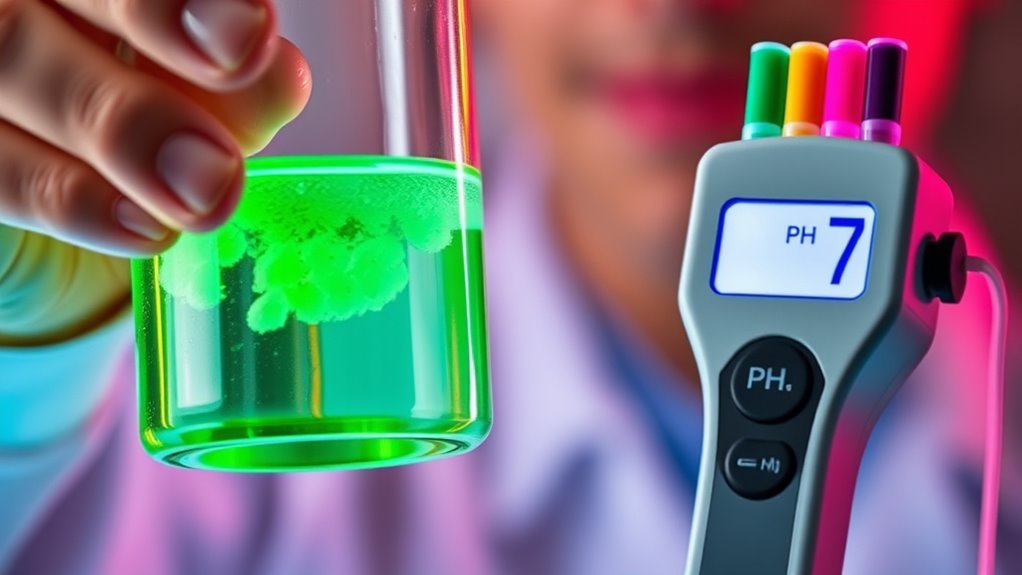
Did you know that pH levels directly impact your health and the environment around you? In your body, pH influences digestion, with stomach acid helping break down food, and blood pH must stay between 7.35 and 7.45 to keep you healthy. Saliva pH affects tooth decay, so brushing regularly helps maintain a neutral environment. Outside your body, soil pH affects plant growth by controlling nutrient availability; too acidic or basic soils can hinder crops. Some plants and animals produce pH-based defenses against predators or adapt to specific pH environments. Additionally, AI-powered analysis is increasingly used to monitor and optimize environmental pH levels, helping to protect ecosystems and ensure sustainable agriculture. Food and beverages also depend on pH for taste, preservation, and safety.
How Ph Affects Water Quality and Ecosystems

pH levels play an essential role in maintaining water quality and supporting healthy ecosystems. If the pH drifts outside the ideal range of 6.5 to 8, aquatic life experiences stress, which can reduce growth, reproduction, or cause death.
Elevated pH levels can damage fish gills and skin, while low pH causes metals to dissolve more readily, polluting water and harming organisms. Fluctuations in pH disrupt chemical processes like nutrient availability and dissolved oxygen levels, threatening species diversity. The increasing adoption of AI-driven security systems enhances monitoring of water quality parameters, helping detect pH changes early and prevent ecological damage.
A stable pH helps sustain ecosystem balance, ensuring water parameters like oxygen and nutrients stay within safe limits. Pollution or human activity that alters pH can destabilize ecosystems, leading to reduced biodiversity and compromised water quality—both essential for aquatic health and overall environmental stability.
The Role of Ph in Agriculture and Soil Health
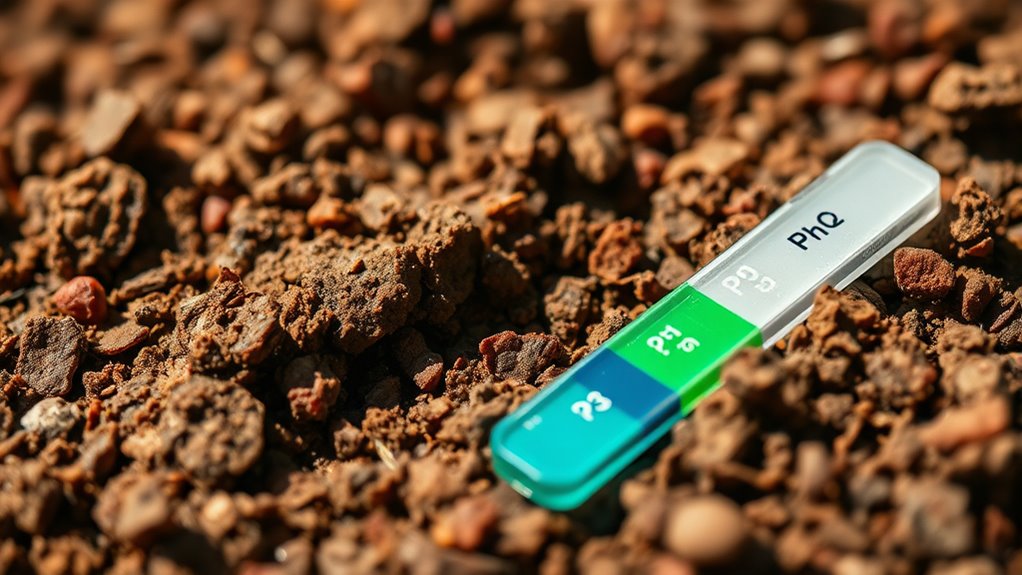
Maintaining proper soil pH is essential for agricultural success, directly influencing nutrient availability, microbial activity, and plant growth. When soil pH is too acidic or alkaline, nutrients like phosphorus, iron, and molybdenum become less accessible or toxic, impairing plant health. Juice cleanse and detox practices highlight the importance of balanced intake, similar to how maintaining optimal soil pH ensures healthy plant development. Microbial activity thrives in slightly acidic to neutral soils, supporting decomposition and nutrient cycling, which benefits crop yield. Extreme pH levels can slow bacterial activity and favor fungi, disrupting soil balance. Most crops grow best in pH 5.5 to 7.5, but sensitivities vary among plant species. To optimize soil conditions, farmers often lime acidic soils, adjust fertilizers, select suitable crops, and regularly test soil pH. These practices help guarantee nutrients are available, microbes remain active, and plants grow strong.
Ph and Human Health: Why It Matters in Medicine
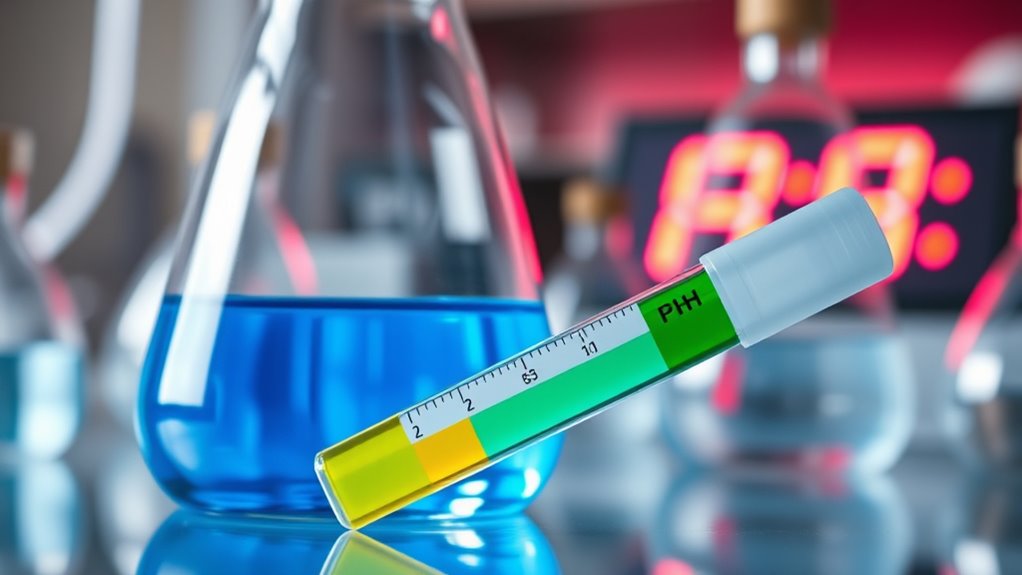
Understanding how pH affects human health is essential because it influences many bodily functions, from digestion to hormone regulation. When your body’s pH balance shifts, it can cause acidosis or alkalosis, leading to symptoms like fatigue, headaches, confusion, or vomiting.
Chronic issues such as kidney failure can disrupt pH levels long-term, while temporary causes like dehydration or intense exercise also impact balance. Your blood pH should stay between 7.35 and 7.45; falling below or rising above causes serious complications, including coma.
The body maintains this narrow range through mechanisms like kidney function. Monitoring and managing pH levels are crucial for overall health, as imbalances affect organ function, metabolism, and hormone regulation, emphasizing the importance of pH in maintaining ideal health.
Applications of Ph Measurement in Science and Industry
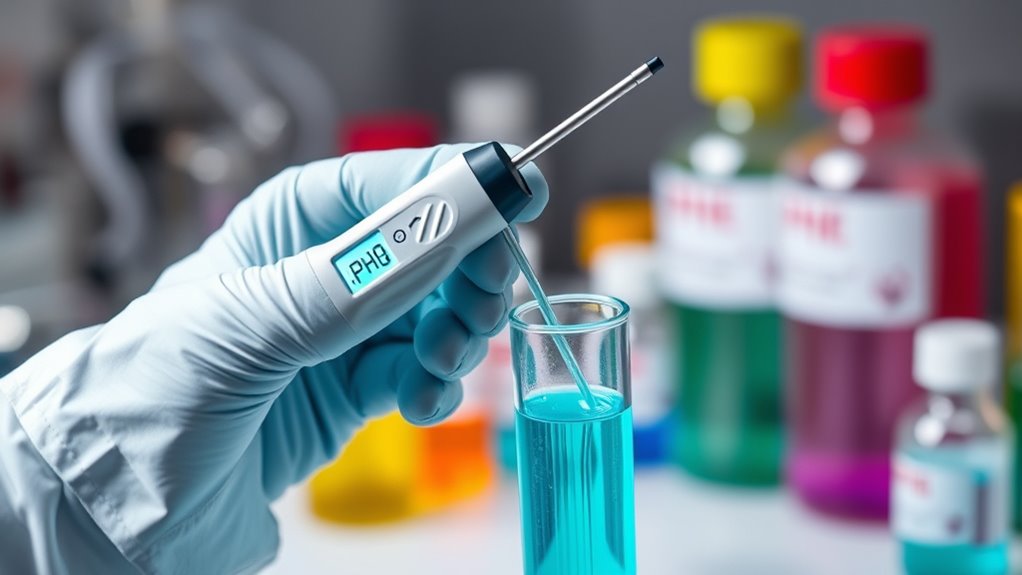
Measuring pH plays a critical role across various fields of science and industry by providing essential data to control and optimize processes.
Accurate pH measurement is vital for optimizing processes and ensuring safety across multiple industries.
In water treatment, pH guarantees effective disinfection, prevents pipe corrosion, and helps meet environmental standards. It’s indispensable for managing wastewater and supporting biological treatment processes.
In the food and beverage industry, pH influences taste, texture, and preservation, while controlling fermentation and preventing spoilage.
In pharmaceuticals, pH affects drug stability, solubility, and safety, supporting quality control and formulation development.
Agriculture relies on soil pH measurements to improve crop yields and nutrient uptake.
Industrial processes, like paper manufacturing, oil refining, and metal finishing, depend on pH regulation to enhance product quality, efficiency, and environmental compliance.
Accurate pH data is fundamental for process consistency and safety across these sectors.
Understanding pH measurement is also crucial for developing new materials and testing products in various industries.
Practical Tips for Understanding and Managing Ph Levels

Effective management of pH levels begins with knowing how to accurately assess them. Use reliable tools like pH meters, test strips, or indicator solutions to get precise readings. Regular testing helps catch imbalances early, so you can take action before problems escalate. Guarantee your equipment is properly calibrated for accurate results. Incorporating data analytics can further enhance your understanding of pH fluctuations over time, enabling more proactive adjustments. When adjusting pH, choose the right chemicals—acidic solutions like sulfuric acid lower pH, while alkalis like lime raise it. In water and soil management, techniques like aeration or liming can help maintain ideal levels.
For pools and aquariums, consistent testing and timely adjustments keep environments safe and healthy. Remember, understanding your pH levels allows you to troubleshoot issues effectively, protect ecosystems, and improve the quality of your environment or products.
Frequently Asked Questions
Can Ph Levels Vary Significantly in Different Parts of the Same Water Body?
You’re asking if pH levels can vary within the same water body, and the answer is yes. Different areas can have distinct pH values due to factors like inflows, groundwater, and nearby geology.
Organic matter, human discharges, and chemical inputs also influence local pH. These variations affect habitats and species, making it essential to monitor pH across different zones to understand the overall health and quality of the water body.
How Does Temperature Influence Ph Measurements in Real-World Applications?
When it comes to real-world pH measurements, temperature is the silent conductor affecting every note. You’ll notice that higher temperatures often lower pH readings because they boost ionization and ion mobility.
You must record the temperature and use automatic temperature compensation to keep your readings accurate. Regular calibration and proper sensor placement ensure that temperature’s influence doesn’t distort your results, helping you make informed decisions and avoid costly mistakes.
Why Do Some Solutions Have Ph Values Outside the 0-14 Range?
Some solutions have pH values outside 0-14 because their hydrogen or hydroxide ion concentrations are extremely high, exceeding 1 molar. When acids are very concentrated, they can produce pH below 0; similarly, strong bases can have pH above 14.
Instrumental and chemical limitations prevent accurate measurement beyond this range, but theoretically, pH can extend infinitely due to its logarithmic nature, especially in specialized or industrial settings.
What Are Common Mistakes to Avoid When Measuring Ph?
When measuring pH, you should avoid common mistakes like neglecting proper calibration with fresh, multi-point buffers, and not cleaning or storing electrodes correctly.
Always guarantee your electrodes are hydrated and stored properly, and use temperature compensation to account for fluctuations.
Don’t rush calibration or measurement, and verify sample pH falls within calibration range.
These steps help you get accurate, reliable pH readings every time.
How Quickly Can Ph Levels Change in Natural Environments?
You’re asking how fast pH levels can shift naturally. In unbuffered systems, heavy rainfall or acid rain can cause pH to drop within hours. Organic decay gradually lowers pH over months.
Daily cycles, like photosynthesis, can cause pH to fluctuate up to 1 unit. Sudden events, such as chemical spills, can drastically alter pH in minutes.
Conclusion
Just like the ocean’s depths hold secrets beneath their surface, understanding pH reveals hidden truths about our world and health. By paying attention to pH levels, you become a steward of your environment and well-being. Remember, balance is key—too much acidity or alkalinity can disrupt life’s delicate harmony. Embrace this knowledge as your compass, guiding you to make informed decisions and nurture a healthier, more balanced world.


